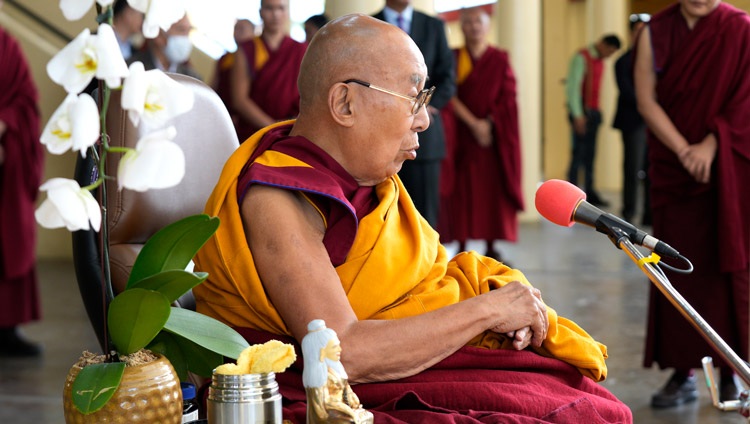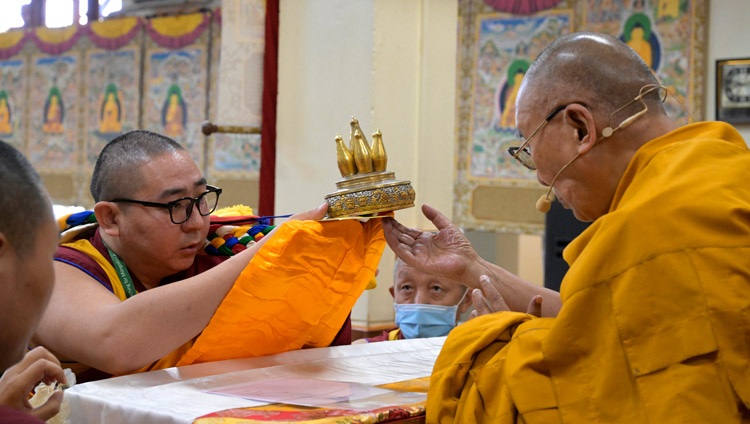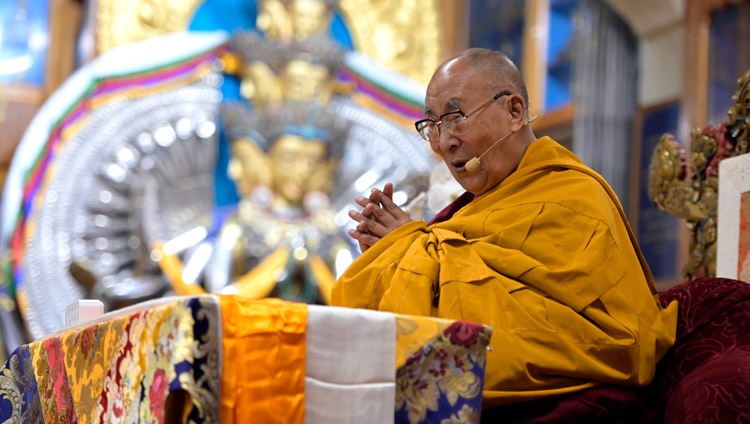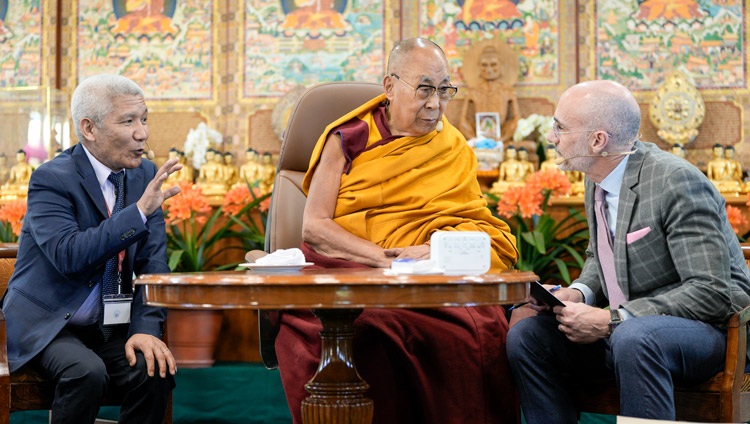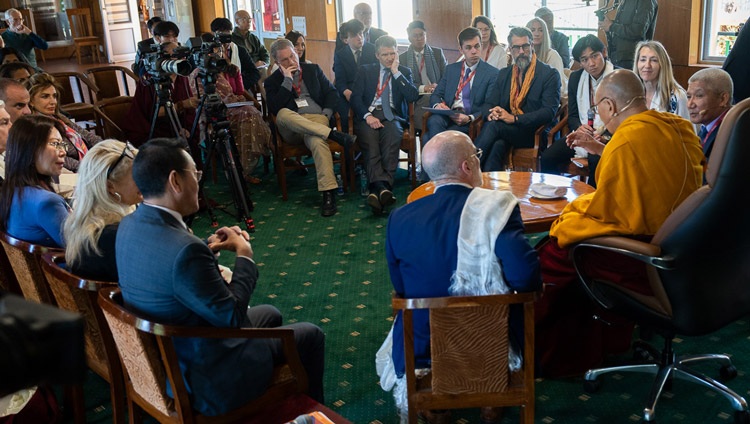His Holiness the Dalai Lama gives “In Praise of Dependent Arising & Avalokiteshvara Empowerment”
Thekchen Chöling, Dharamsala, HP, India – This morning, the second day of Saga Dawa, the most sacred month in the Tibetan Buddhist Year, His Holiness the Dalai Lama walked steadily from the gate to his residence to the Tsuglagkhang, the Main Tibetan Temple. He clearly enjoyed the opportunity to make direct contact with members of the public, young and old, approximately 9500 of whom packed the temple and yard. As His Holiness cast his smiling gaze over the faces of the crowd, they invariably smiled in return.

His Holiness the Dalai Lama greeting the audience of Tibetan young people as he arrives at the Main Tibetan Temple for the first day of his Teachings for Tibetan Youth in Dharamsala, HP, India on June 1, 2022. Photo by Tenzin Choejor
“We have a tradition of teaching Tibetan students and school-children in June,” His Holiness declared from the throne, “and as part of that I’m going to give an Avalokiteshvara empowerment. We’ll do the preliminaries today and the actual empowerment tomorrow.
“Khyongla Ratö Rinpoché, a very good friend of mine recently passed away. Ratö Monastery offered a mandala to me and requested that I compose a prayer for Rinpoché’s swift return. Today, the Monastery have provided the tea and bread being distributed here, as well as pecuniary offerings to the Sangha.”
Indicating a statue behind him, His Holiness explained, “Here we have the statue known as Wati Sangpo or Kyirong Jowo. During the time of the Fifth Dalai Lama this statue and another one similar to it, the Avalokiteshvara brothers, were brought together in the Potala and my predecessor meditated in their presence.
“Monks of Dzongkha Chödé Monastery and members of Chushi Gangdruk were involved in bringing this Kyirong Jowo out of Tibet to Nepal. Eventually it was brought here to Dharamsala and placed in my safe-keeping. I remember that when first saw it, I was filled with happiness. When Dzongkha Chödé Monastery was re-established in South India a question arose about where the statue should stay. I performed a divination that indicated that it would be favourable if it stayed with me.
“I feel that his expression changes and sometimes he seems to smile. Anyway we’ve set him up here in this temple for the duration of our collection of 100 million mani mantras this month.

His Holiness the Dalai Lama talking about the Kyirong Jowa statue in the glass case behind him during the first day of his Teachings for Tibetan Youth in Dharamsala, HP, India on June 1, 2022. Photo by Tenzin Choejor
“One night after we came into exile, I had a dream of visiting the Jokhang Temple in Lhasa. I came to a chapel containing a thousand armed Mahakarunika statue known as the Self-manifesting Avalokiteshvara with Five Features. He seemed to be winking and beckoning me in. I embraced him and he recited a verse from the Prayer to Maitreya—
Through [the power of] previous perseverance
Having become stable, enthusiastic, and free of laziness,
And with a strong body and mind,
Perfect the paramita of joyous effort.
“The gist of this verse is not to give up, but to keep up your courage, resolve and determination. Shortly afterwards during the cultural revolution, this statue was broken up. Some pieces from it found their way here and I installed some of them in the Avalokiteshvara statue we have here in this temple.
“Seeing the Guru Rinpoché statue here reminds me that I also installed a statue of him in Lhasa to commemorate the special connection he has with us Tibetans and the establishment of Buddhism in Tibet.”
His Holiness noted that the proceedings for the empowerment and teaching were being live webcast. He mentioned that he’s received several enquiries from people who wanted to know if they could really receive the empowerment by this means. His answer was, “Yes, if your faith and commitment are unwavering. Tibetans and Chinese Buddhists too have a special connection with Avalokiteshvara, so if your faith and bond of trust are strong, distance is no object. I will keep you all in mind as I go through the procedures.”
His Holiness remarked that he would teach ‘In Praise to Dependent Arising’ as part of the preparations for the empowerment. He noted that he had received and explanation of it from Ling Rinpoché as well as Gyen Nyima and others. He acknowledged that the author, Jé Tsongkhapa took great interest in emptiness, noting that he reflected deeply on dependent arising and emptiness and received guidance in visions of Manjushri.
His Holiness told the story of Tsongkhapa’s being in a purification and accumulation retreat on Manjushri’s advice when he had a vision in the form of a dream. He saw Nagarjuna surrounded by his disciples. One of them, who he recognised as Buddhapalita, stepped forward and touched a book to Tsongkhapa’s head. The book was Buddhapalita’s commentary to Nagarjuna’s Fundamental Wisdom of the Middle Way’. When Jé Rinpoché read it the following day, he came upon a passage that prompted him to gain certitude about emptiness and dependent arising.

His Holiness the Dalai Lama speaking on the first day of his Teachings for Tibetan Youth at the Main Tibetan Temple in Dharamsala, HP, India on June 1, 2022. Photo by Tenzin Choejor
His Holiness reported that he has great faith in Tsongkhapa’s teaching on emptiness and that Gyen Nyima told him that he had read Jé Rinpoché’s ‘Ocean of Reasoning’ to students many times, but no one asked questions about it the way His Holiness did.
His Holiness revealed that he expects to reach the path of preparation in this life. With regard to the correct view, he cited three verses from chapter six of ‘Entering into the Middle Way’ that mention the four logical absurdities that ensue if it is asserted that things and beings exist inherently. They are that a noble being’s mind, totally absorbed in emptiness, would be a destroyer of entities; that conventional truth would withstand the analysis of a reasoning mind; that the absolute production of things could not be denied, and that the Buddha’s statement ‘phenomena lack self-existence’ would not hold true.
Since he feels driven to read Chandrakirti every day, His Holiness sometimes wonders if he might have been a student at the end of the row in one of the great Indian master’s discourses. The important point he emphasized was that nothing has objective existence from its own side. He compared this to the quantum physics view of things as projections of the mind, which accords with the Buddhist view of things being mere mental designations.
His Holiness concluded his preamble by quoting verses from Shantideva:
All those who suffer in the world do so because of their desire for their own happiness. All those happy in the world are so because of their desire for the happiness of others. 8/129
For those who fail to exchange their own happiness for the suffering of others, Buddhahood is certainly impossible – how could there even be happiness in cyclic existence? 8/131
He also gave a reading transmission of Jé Tsongkhapa’s ‘Foundation of All Good Qualities’ and then began preparations he had to make prior to beginning the empowerment rite. As part of the preparation of the disciples he gave the Bodhisattva Vows.

Young Tibetans taking Bodhisattva Vows from His Holiness the Dalai Lama on the first day of his Teachings for Tibetan Youth at the Main Tibetan Temple in Dharamsala, HP, India on June 1, 2022. Photo by Tenzin Choejor
His Holiness opened his reading of ‘In Praise to Dependent Arising’ by reciting two verses from Nagarjuna’s ‘Fundamental Wisdom’:
I prostrate to the Perfect Buddha,
The best of teachers, who taught that
Whatever is dependently arisen is
Unceasing, unborn,
Unannihilated, not permanent,
Not coming, not going,
Without distinction, without identity,
And free from conceptual construction.
As he read briskly through the verses he commented that ignorance involves grasping at the existence of an independent self, whereas things arise in dependence on causes and conditions. As Choné Lama Rinpoché remarked, dependence does not deny emptiness, and arising means things conform to worldly convention.
His Holiness pointed out that dependent arising can be proved through reason and logic, which he attributes directly to India’s analytical traditions. He recalled that King Songtsen Gampo commissioned a style of Tibetan writing modelled on the Indian Devanagari Sanskrit alphabet. Later, King Trisong Detsen invited Shantarakshita from India and he encouraged the translation of Buddhist literature into Tibetan. Subsequently, Trisong Detsen presided over discussions between Shantarakshita’s disciple Kamalashila and Chinese meditators about the most appropriated approach to enlightenment. He decided that the Indian analytical tradition was better suited to the Tibetan mind and asked the Chinese meditators to leave the Land of Snows.
“In the past in Tibet,” His Holiness observed, “we had great seats of learning where monks underwent rigorous study. Several of these educational institutions have been re-established in South India. Scholars from them have engaged in fruitful discussions with modern scientists, particularly about the workings of the mind and the nature of reality. Having studied, taken the exams and qualified as a Geshé, I believe it was the strict training I underwent in reason and logic that has equipped me to engage in discussions with scientists and question where I think there are contradictions in their position.
As he completed his reading of ‘In Praise to Dependent Arising’ His Holiness repeated that he reflects intensely on bodhichitta and emptiness every day. He regularly reads Chandrakirti’s ‘Entering into the Middle Way’ and its auto-commentary. However, while he admires the clarity of these works, he also acknowledges Chandrakirti’s observation that being learned is not necessarily sufficient grounds for being able to comprehend emptiness.
This suchness just explained is most profound and terrifying, yet people with past habituation will certainly realize it;
others, however, despite vast learning, will fail to comprehend.
Thus, seeing those other traditions as constructed by the authors’ own minds, as akin to the treatises that set forth propositions on self,
forsake admiration for treatises and systems contrary to this one. 11.55
Tomorrow, His Holiness will grant the empowerment of 1000 Armed Avalokiteshvara.

